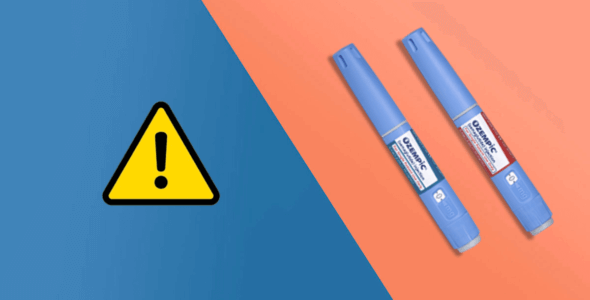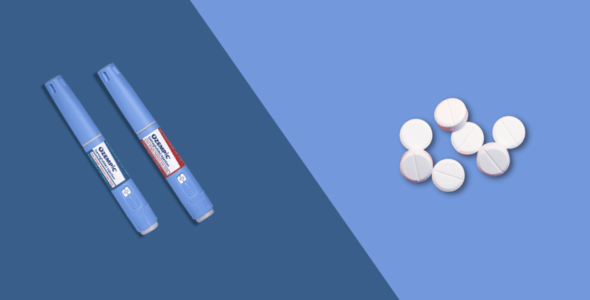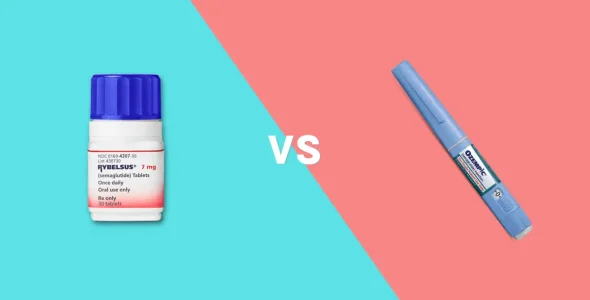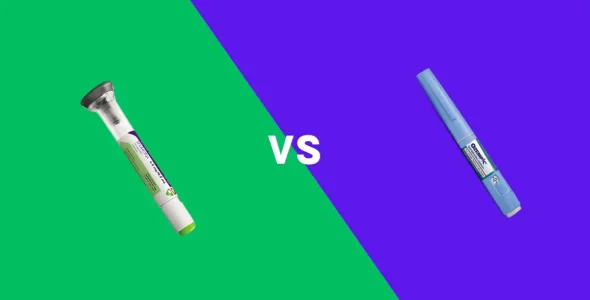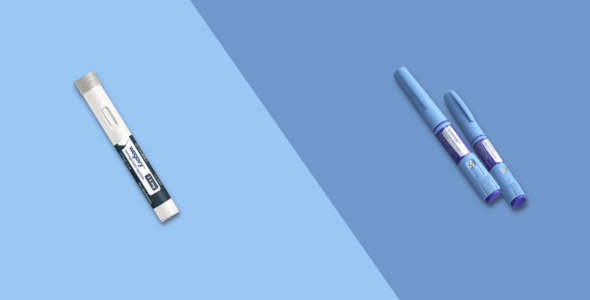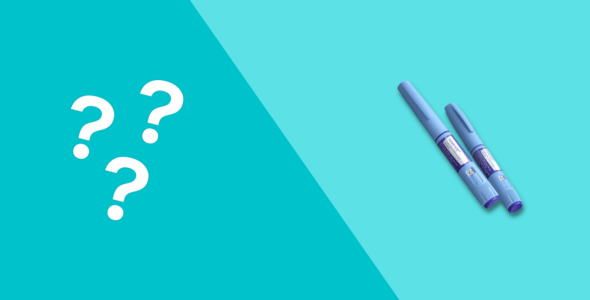Saxenda and Ozempic are prescription drugs approved by the U.S Food and Drug Administration. Both drugs are glucagon-like peptide-1 receptor agonists, administered by injection and have similar gastrointestinal side effects. However, they are licensed to be used for different indications. Saxenda is a weight loss medication and Ozempic is a diabetes medication. Lets take a look at the similarities and differences between the two drugs.
What is Saxenda?
Saxenda contains the prescription medicine liraglutide. Liraglutide is similar to a naturally occurring hormone in the body that controls digestion, insulin levels, and blood sugar levels. Saxenda is recommended alongside a reduced-calorie diet and an increase in physical activity. It is used to manage body weight loss and obesity in adult patients with a body mass index (BMI) of
- 30 kg/m2 or more, or
- 27 kg/m2 or more, if you have high blood pressure, type 2 diabetes, or high cholesterol, triglycerides, or a low HDL cholesterol level that is making plaque build up in your arteries worse
Saxenda is not specifically for the treatment of type 1 or type 2 diabetes or weight loss. Saxenda is part of a treatment plan that will include, diet, exercise, and weight management.
Saxenda is given as a subcutaneous injection under the skin. It can be given at any time of the day, with or without a meal. Saxenda comes in a prefilled pen. You should not inject into the same place two times in a row. If the injection has particles in it or changed color, do not use it. Speak to your pharmacist about a new medicine. You should dispose of used needles and syringes by using a puncture-proof disposal sharps container. Store unopened pens in the refrigerator. In-use pens may be kept at room temperature for up to 30 days. Always remember to store your medicine out of the reach of children and pets.
Brand name drug Victoza contains the same active ingredient as Saxenda but is used for the treatment of type 2 diabetes. The difference is in the dosage.
Saxenda active ingredients
Liraglutide is classed as an acylated human glucagon-like peptide-1 (GLP-1) receptor agonist. Liraglutide binds to and activates the GLP-1 receptor. Unlike naturally occurring GLP-1 in the body, which has a half-life of up to 2 minutes, liraglutide is stable against breakdown by enzymes in the body and has a half-life of 13 hours. Because liraglutide has delayed absorption and plasma protein binding and has a half-life of 13 hours it can be given once daily by subcutaneous injection.
GLP-1 is classed as a physiological regulator of appetite and calorie intake. This means it works by a method known as negative feedback. The GLP-1 receptor is seen in several areas of the brain involved in appetite regulation.
Side effects of Saxenda
The most common possible side effects caused by Saxenda include:
- Nausea, vomiting, and stomach pain
- Diarrhea
- Constipation
- Fast heart rate
- Tiredness
- Headaches and dizziness
In rare instances, Saxenda can cause more serious side effects. These can include:
- Increased heart rate
- Suicidal thoughts or sudden changes in behavior and mood
- Severe nausea, vomiting, or diarrhea that will not stop
- Hypoglycemia (very low blood sugar levels) – feeling very weak, shaking, confused, sweating, fainting, or seizures
- Pain or difficulty urinating, swelling in ankles or feet, tiredness, and difficulty breathing
- Trouble swallowing, lump, or swollen neck
- Jaundice – yellowing of eyes or skin, darker stools, upper stomach pain spreading to the back
Your doctor will assess the benefits of using Saxenda against your risk of side effects.
Saxenda drug interactions
Saxenda can interact with other medications. These include:
- Bexarotene – cancer treatment
- Gatifloxacin – an antibiotic
- Insulin – aspart, detemir, glargine, lispro
- Oral diabetes medicines – glipizide, glimepiride
- Antiviral medication – amprenavir, atazanavir, darunavir, ritonavir, saquinavir
- Diuretics – bendroflumethaizide, bumetanide, furosemide
- Antibiotics – ciprofloxacin, clarithromycin, norfloxacin
- Corticosteroids – dexamethasone, fludrocortisone, prednisolone
This list is not exhaustive and other drugs may interact with Saxenda.
Saxenda warning and precautions
You should not use Saxenda if you:
- Are allergic to the active ingredient liraglutide
- Are allergic to any of the other ingredients in Saxenda
- Are using insulin or albiglutide, dulaglutide, or exenatide
- Have multiple endocrine neoplasia type 2
- Have a family history of medullary thyroid carcinoma
- Have diabetic ketoacidosis
- Are under 18 years of age
Talk to your doctor before using Saxenda if you:
- Are taking any of the medications that could interact with Saxenda
- Have kidney disease
- Have liver disease
- Have high cholesterol or triglycerides
- Have heart problems
- Have problems with your pancreas or gallbladder
- Have depression or suicidal thoughts
- Have stomach or digestion problems
- Are pregnant or are planning to become pregnant
- Are breastfeeding or are planning to breastfeed
What is Ozempic?
Ozempic is the brand name of an FDA approved medication manufactured by Novo Nordisk and given to adults with type 2 diabetes to:
- Lower blood sugar (glucose) levels, when used alongside exercise and diet changes
- Reduce the risk of major cardiovascular events, like heart attacks and strokes, in people who have heart disease
Ozempic can help you lower your blood sugar levels when used alongside dietary and lifestyle changes. It causes you to secrete more insulin, helping to lower your blood sugar and reduce your risk of major cardiovascular events, like heart attacks and strokes, if you have heart disease. It is sometimes prescribed with metformin for diabetes treatment.
Brand name drug Rybelsus contains the same active ingredient as Ozempic but in a tablet form.
Ozempic active ingredients
The active ingredient in Ozempic is semaglutide. It is classed as a glucagon-like peptide-1 receptor agonist (GLP-1 receptor agonist). Semaglutide reduces blood glucose through a mechanism where it stimulates insulin secretion and lowers glucagon secretion by selectively binding to and activating the GLP-1 receptor.
Unlike many other treatments for type 2 diabetes, semaglutide is not a type of insulin. It is a human hormone that acts on different parts of your body. Semaglutide encourages your pancreas to produce more insulin, helping to lower your blood sugar after you’ve eaten. It also appears to increase the growth of the cells in your pancreas that produce insulin (beta-cells).
The semaglutide injection is injected under the skin (subcutaneous) usually once every 7 days. The injection sites are the thigh, abdomen, or upper arm. The dose you receive is based on your medical condition and your response to treatment. If you miss your weekly dose of Ozempic and there are less than 3 days until your next dose, do not take the missed dose. The Ozempic injection can be stored at room temperature or in the refrigerator.
Side effects of Ozempic
The most common side effects caused by Ozempic include:
- Nausea (feeling sick)
- Vomiting (being sick)
- Abdominal pain
- Constipation
- Diarrhea
In rare instances, Ozempic can cause more serious side effects, including:
- An increased risk of thyroid tumors, including cancerous tumors
- Kidney problems, including kidney failure
- Severe allergic reactions to the medication can cause itching, rashes, swelling, and difficulties breathing
- Inflammation of your pancreas (pancreatitis)
- Changes in your vision
- Very low blood sugar (hypoglycemia)
RELATED: Ozempic side effects
Ozempic drug interactions
Ozempic can also interact with the following medications:
- Any medications you take orally to reduce the risk of blood clots (oral anticoagulants) like warfarin
- Insulin – Ozempic can be used alongside insulin, but your doctor may change the dose of insulin you take and/or how often you take insulin
- Any other medications taken to treat type 2 diabetes
Ozempic warnings & precautions
Don’t take Ozempic if you:
- Are allergic to the active ingredient semaglutide, or any of the other ingredients in Ozempic
- Have had, or anyone in your family has had, a type of thyroid cancer called medullary thyroid carcinoma (MTC)
- Have an endocrine system condition called multiple endocrine neoplasia syndrome type 2 (MEN 2)
- Have pancreatitis
- Have type 1 diabetes (Ozempic is for type 2 diabetes only)
- Are under 18 years of age
Talk to your doctor before taking Ozempic if you:
- Have had any problems with your pancreas or kidneys
- Have ever had diabetic retinopathy
- Are pregnant or are planning to become pregnant
- Are breastfeeding or are planning to breastfeed
Read the full prescribing information for Saxenda and Ozempic and always speak with your healthcare provider for medical advice about your medicine so they can monitor and evaluate your condition.

